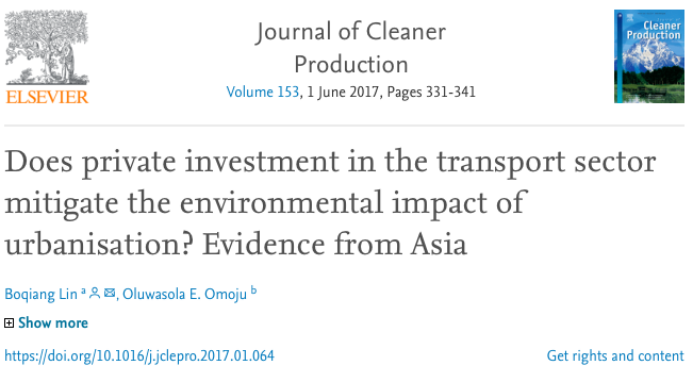
题目:运输部门的私人投资是否减轻了城市化对环境的影响?来自亚洲的证据(Does private investment in the transport sector mitigate the environmental impact of urbanisation? Evidence from Asia)
作者:林伯强*,Oluwasola E.Omoju
期刊:清洁生产(Journal of Cleaner Production)
详细:第153卷,2017年6月1日,第331-341页
DOI:https://doi.org/10.1016/j.jclepro.2017.01.064
文献导读:
亚洲经济体在过去几十年里快速的经济增长被称为“亚洲奇迹”,这引起了全球的关注,其发展路径被认为是可以被其他发展中国家效仿的。亚洲的城市化率增长速度比任何其他地区都要快。但是同时从整体上看,亚洲目前的CO2排放量居世界首位。与城市化相关的主要挑战之一是对交通、能源、水和卫生等实体基础设施的需求增加。城市化通过增加对交通的需求推动了人口流动和交通运输发展。因此,城市基础设施建设将在决定未来气候变化方面发挥重要作用。
交通部门是CO2排放的第二大排放来源,仅次于能源部门。因此,城市的可持续发展需要长期规划、大量投资以及能够适应气候变化的交通基础设施。因此,迫切需要研究城市化对交通运输部门CO2排放的影响,特别是交通基础设施和融资模式。
因此,本研究的主要目的是研究亚洲城市化、铁路运输基础设施、私营部门在运输部门的投资与运输部门CO2排放之间的关系。城市化和其他经济因素对环境的预期影响是长期的,面板协整和FMOLS适用于本文的分析。
本文具体研究内容包括:(1)分析亚洲城市化对交通部门CO2排放的影响。(2)确定城市化对运输部门CO2排放的影响是否取决于运输基础设施模式和私营部门对该部门的投资。
本文发现,城市化对交通部门二氧化碳排放的影响取决于模型中的变量以及城市化与其他因素的相互作用。收入和人口的增加导致了运输部门CO2排放量的增加,而技术进步则减少了运输部门的排放量。私营部门的投资和铁路运输系统的发展也减少了运输部门CO2的排放量。
Abstract:
Urbanisation serves as a pillar for creating prosperous economies, but its impacts on infrastructure and the environment have been a concern for policy makers. There are numerous studies that examine the impact of urbanisation on the environment but no known study has analysed whether the impact of urbanisation on the environment is dependent on the characteristics of available infrastructure. To address this gap, this study uses the STIRPAT model, panel cointegration and fully modified ordinary least square (FMOLS) estimator as well as panel data of eight Asian countries to analyse whether private sector investment in the transport sector and transport infrastructure mode influences the impact of urbanisation on transport CO2 emissions. We find that the effect of urbanisation on transport CO2 emissions depends on the covariates in the model and interactions with other factors. Increase in income and population increases transport CO2 emissions while technological improvements reduces CO2 emissions from the transport sector. Private sector investment in the transport sector and availability of rail infrastructure reduce transport CO2 emissions; and given the same level of urbanisation, Asian countries with more rail infrastructure and private sector investment in the transport sector tend to have lower CO2 emission from the transport sector. Policy makers in Asia should make efforts to boost private sector participation in the transport sector and also promote the construction and improvement of rail infrastructure in order to reduce urbanisation-induced transport CO2 emissions.
Keywords: Optimal carbon pricing; Environmental externalities; Policy modeling; Welfare
 厦大总机:0592-2180000
|
地址:福建省厦门市思明区思明南路422号
|
邮政编码:361005
厦大总机:0592-2180000
|
地址:福建省厦门市思明区思明南路422号
|
邮政编码:361005